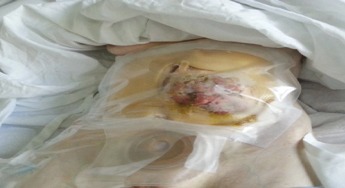
Behandlung von Pseudomyxoma peritonei
Bei diesem Fallbericht geht es um die Behandlung von Pseudomyxoma peritonei mithilfe von eakin Woundpouches™
Von Deb Day, Stomal Therapy CNC Central Coast Local Health District, Australien
Krankengeschichte
47-jährige Frau, bei der vor 13 Jahren Pseudomyxoma peritonei diagnostiziert wurde. Zahlreiche Operationen und ein linksseitiges Ileostoma mit hohen Ausscheidungsmengen. Die Patientin war sehr unabhängig und lebte zu Hause, wo sie eine totale parenterale Ernährung (TPE) und intravenöse Flüssigkeiten (IVF) über einen Hickman-Katheter erhielt.


Die Patientin stellte sich im Juli 2014 in der stomatherapeutischen (STN) Sprechstunde vor und wurde an ihren Chirurgen rückverwiesen, der ein Pseudomyxoma-peritonei-Rezidiv diagnostizierte. Später wurde entschieden, dass bei der Patientin keine weitere Operation durchgeführt wird.
Pflegeplan
Die Patientin wurde palliativ behandelt und erhielt weiterhin eine TPE, IVF und Bluttransfusionen. Zur Schmerzlinderung wurde darüber hinaus eine Spritzenpumpe eingesetzt.


Die Versorgung des Pseudomyxoma peritonei mit eakin Woundpouches™ war eine passende Lösung, da die Wundbeutel Komfort für die Patientin, Geruchskontrolle und das Auffangen der Wundflüssigkeit ermöglichten. Auf diese Weise ging auch die Arbeitsbelastung der betreuenden Pflegekräfte zurück.
Ergebnis
• Auffangen der Flüssigkeit möglich.
• Komfort und Geruchskontrolle für die Patientin.
• Verringerte Arbeitsbelastung der Pflegekräfte.
• Keine zusätzlichen Komponenten oder Abhängigkeit von Ressourcen wie z. B. Strom.


 DE
DE 